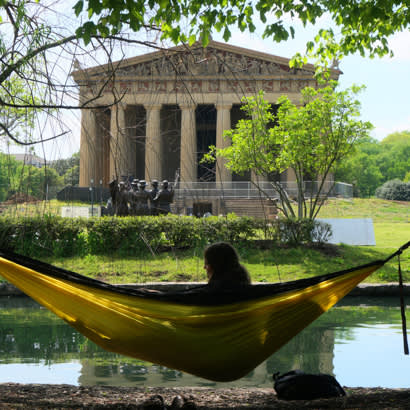
For an enhanced digital experience, read this story in the ezine.
The Nashville (Tennessee) Parthenon is the city’s iconic landmark, a beloved symbol of civic pride for Nashvillians since its original manifestation as the art building for the Tennessee Centennial Exposition in 1897. The building is the world’s only full-scale replica of the original temple in Athens, Greece. As Nashville’s oldest art museum, this landmark was listed on the National Register of Historic Places in 1972.
The museum’s upper level is graced by a colossal 42-foot statue of the goddess Athena and features casts of the original Parthenon’s pedimental fragments, which were purchased from the Victoria and Albert Museum so that sculptors Leopold and Belle Kinney Scholz could be as accurate as possible when recreating the pediments. The Parthenon’s lower level houses four galleries, featuring the Cowan Collection, temporary exhibitions and a collection of artifacts from the 1897 exposition — many of which are on loan from Nashville collector David Ewing. The 2021 temporary exhibits include: The One and Only Harry Shepherd, showcasing the works of the African American photographer and early civil rights activist who won a Decorative Arts award at the Tennessee Centennial Exposition; The Looking Glass, a collection of large-scale self-portraits by the acclaimed music photographer Lynn Goldsmith, which are designed to “highlight the psychological relationship between what we see and what we imagine”; Kindred Links: Spirits and Forms from the Urban Landscape, exploring contemporary urban life through the eyes of two of Nashville’s most prominent African American artists Omari Booker and Henry Jones, and serving as an important window into the effect gentrification is having on historically black neighborhoods.
For nearly a century, this iconic museum has fulfilled its purpose to be a cultural center for the arts and an educational resource for the city of Nashville, drawing 350,000 visitors annually. Public programming in the humanities is a critical part of the Parthenon’s mission, as the museum is a leading educational resource and often the window through which Nashvillians and visitors view our unique civic history. The Nashville Parthenon also presents ongoing educational programming that includes tours led by museum docents, a science, technology, engineering arts and math (STEAM) partnership with Metro Public Schools, gallery interactive displays, symposia, annual lectures presented in conjunction with the Archaeological Institute of America and Kidsville at the Parthenon, which provides storytelling, crafts and active play activities for families on Saturday mornings.
The Nashville Parthenon is owned and operated by the Metropolitan Government of Nashville and Davidson County’s Parks and Recreation Department, led by Park Director Monique Odom. The Parthenon has been managed by Museum Director Wesley Paine for more than four decades. She is supported by Assistant Director Lauren Bufferd, Curator Mark Medley and Education Director Katie Petrole. Centennial Park Conservancy, led by Executive Director John Tumminello and Parthenon Partnership Director Justin Tam, serves as the Nashville Parthenon’s nonprofit support group.
In addition to hosting Nashville’s Parthenon, Centennial Park encompasses 132 acres of green space that welcomes more than 3 million visitors annually who spend quality outdoor time in the park and attend signature annual events, such as the Celebrate Nashville Cultural Festival, Musicians Corner, Nashville Earth Day, Tennessee craft fairs and big band dances. The park is currently undergoing major improvements as part of the Centennial Park Revitalization, a public-private partnership between Metro Parks and Centennial Park Conservancy to preserve and transform Nashville’s central park for current and future generations.
Learn more about the Parthenon and Centennial Park at nashvilleparthenon.com and centennialparkconservancy.com. To view drone footage of the Parthenon and Centennial Park, visit youtube.com/watch?v=zALtX4NSC-A.

